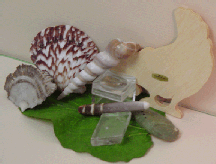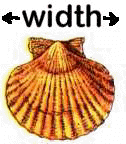BACKGROUND:
Real objects aren't
always a perfect shape. In order to describe such objects, one must
be able to make a "close approximation." Sometimes the endings -ish
or -like can help distinguish a perfect shape from a not-so-perfect shape.
For example, a roundish object or a square-like shape. make a "close approximation." Sometimes the endings -ish
or -like can help distinguish a perfect shape from a not-so-perfect shape.
For example, a roundish object or a square-like shape.
In this lab, students will look
at different objects. They will describe their shape and color.
Students will predict and record the measurements of objects before they
measure them. The metric system is recommended because it is easier
to measure a fractional part of the object. Even if students have
not learned about decimal points, it is easy to say centimeters before
the decimal, millimeters after the decimal. The English system is
difficult to convert because the decimal system basically converts the
English system to metric. Using metric to start with avoids the use
of conversion.
PROCEDURE:
- Pass
out the objects. Tell students that they need to describe the shape
and color(s) of each object. Model how to do this with one student's
object. After recording the shape and color, they need to predict
the object's dimensions. In most cases they need to only guess
at it's length and width. Occasionally they also need to mention
it's height. Remind them that their guesses will not be held against
them if they are wrong. The more they practice measuring the better
their guessing will become.
Reinforce the difference between
length, width, and heigh. Demonstrate how to measure an irregular
object like the abalone shell. Length is the longest length and width
the shortest.
- After they have predicted
the dimensions they can use a metric ruler to measure the object.
Ask them to record their measurements in the spaces provided and compare
it with their prediction.
- The information below
will help you with each of the items.
CUBE WITH MAGNIFYING LENS: Students
should predict the length, width, and height. As an extension, you might
want students to describe the magnification, which is approximately 2 times.
Students can find the magnification by putting a line on a piece of paper.
Next, put the magnifier over the line and draw the apparent height they
see and then compare.
ABALONE SHELL: Students
should count the number of holes, length, and color on one side and the
other side. The holes are used by the abalone as a way to get
water through its body. Remember abalone only have one shell.
 SCALLOP: Students should measure
the length and width and describe the shape. Remember that the length
is the direction in which it is the longest. The width is the other
direction, and the “fattest” portion of the width, is the actual number. SCALLOP: Students should measure
the length and width and describe the shape. Remember that the length
is the direction in which it is the longest. The width is the other
direction, and the “fattest” portion of the width, is the actual number.
 SNAIL: Students should measure
the length and width, and describe the color. The geometry of the
snail is “spiral.” SNAIL: Students should measure
the length and width, and describe the color. The geometry of the
snail is “spiral.”
SEA URCHIN SPINE: Students should
measure the width and length of this sea urchin spine, which was attached
to a sea urchin when it was alive. The spines would radiate from
the sea urchin body, and helps the sea urchin move. Many times people
use the spines in necklaces.
FLOWER CORAL: Students should
measure the width and length and describe the color. This specimen
represents on coral individual. The living animal had tentacles that
trap particles in the water from which it finds food.
LEAF: Students should describe
the length and width and describe color. You may want to replace
this with a real leaf. If possible, use real leaves so students can
also describe the veins.
ANIMAL SHAPE: Describe the shape
and measure length and width. Have students describe without mentioning
the name of the animal. This is difficult.
|